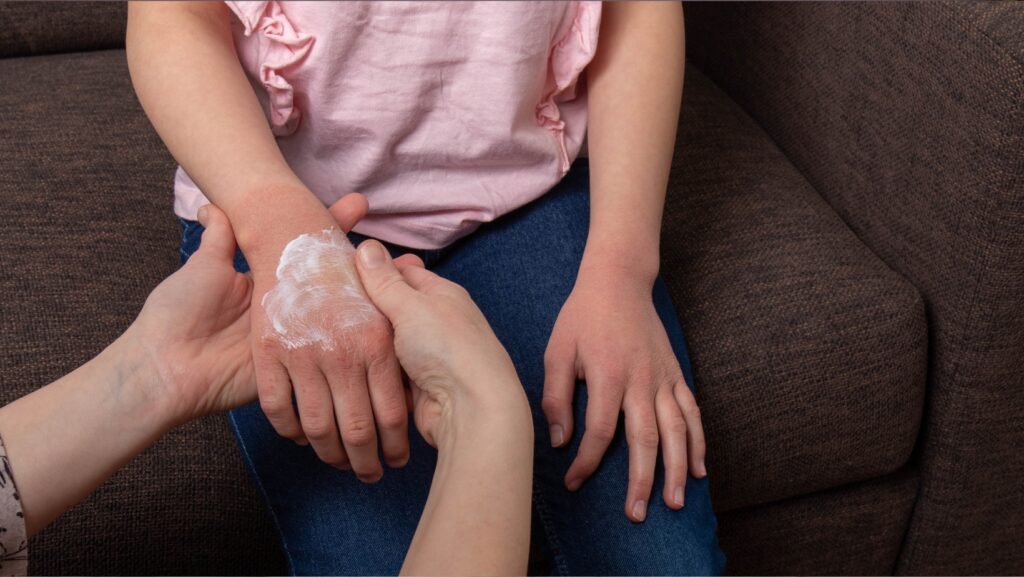Childhood eczema affects many kids. It causes itchy, red, and dry skin. This skin problem can be hard for children and parents to deal with.
Treating childhood eczema helps kids feel better and reduces flare-ups. Common treatments include moisturizers, topical medicines, and avoiding triggers. These methods can ease symptoms and improve skin health.
Doctors work with families to make plans for managing eczema. They may suggest changes at home and special skincare routines. Learning about eczema and its treatments can help parents take good care of their child’s skin.
Understanding Childhood Eczema
Childhood eczema is a common skin condition that affects many kids. It causes dry, itchy skin and rashes. Learning about eczema can help parents manage their child’s symptoms better.
Causes and Triggers
Eczema happens when the skin barrier doesn’t work well. This lets moisture out and irritants in. Genes play a big role in who gets eczema. Kids with family members who have allergies or asthma are more likely to have it.
Many things can trigger eczema flare-ups. Common triggers include:
- Allergens like pet dander, pollen, and dust
- Certain foods
- Soaps and detergents
- Hot or cold weather
- Stress
Figuring out a child’s triggers can help prevent flare-ups. Parents should watch for patterns and talk to a doctor about possible causes.
Symptoms and Diagnosis
Eczema symptoms can vary from child to child. Common signs include:
- Dry, itchy skin
- Red, inflamed patches
- Small bumps that may leak fluid
- Thick, scaly skin

These symptoms often show up on the face, hands, feet, and behind the knees. A pediatric dermatologist can diagnose eczema by looking at the skin and asking about symptoms.
The doctor may also ask about family history and possible triggers. There’s no single test for eczema, but sometimes allergy tests can help find triggers.
Effects on Quality of Life
Eczema can impact a child’s daily life in many ways. The constant itching can make it hard to sleep. This can lead to tiredness and trouble focusing at school.
Some kids feel embarrassed about their skin. They might avoid activities or wear certain clothes to hide their rashes. This can affect their self-esteem and social life.
Eczema can also be stressful for families. Parents often worry about their child’s comfort and try to prevent flare-ups. Regular doctor visits and skincare routines take time and effort.
Despite these challenges, most kids with eczema can lead normal, active lives with proper care and treatment.
Treatment Strategies for Childhood Eczema
Treating childhood eczema involves a mix of daily care, medicines, and flare-up management. The goal is to ease symptoms and prevent future outbreaks.
Daily Skin Care
Good skin care is key for kids with eczema. Bathing in lukewarm water for 5-10 minutes helps hydrate the skin. Parents should use mild, fragrance-free soaps. After bathing, pat the skin dry gently.
Moisturizing is crucial. Apply a thick cream or ointment within 3 minutes of bathing. This locks in moisture. Good choices include petroleum jelly or ceramide-rich products. Use moisturizers at least twice daily.
Some doctors suggest bleach baths to fight skin infections. Mix 1/2 cup of bleach in a full tub of water. Soak for 5-10 minutes, then rinse with clean water.
Medication and Therapies
Doctors often use topical corticosteroids as the first treatment for flare-ups. They come in different strengths. Use as directed by a doctor.

For itching, antihistamines can help. They may also improve sleep. Over-the-counter options work for mild cases.
Antibiotics might be needed if there’s a skin infection. Severe eczema may require stronger drugs like immunosuppressants or biologics.
Some kids benefit from light therapy. This uses UV light to reduce inflammation. It’s done under medical supervision.
Managing Flare-Ups
Knowing eczema triggers helps prevent flares. Common ones include stress, sweat, and certain foods. Keeping a diary can spot patterns.
During a flare, increase moisturizing. Use cool compresses to soothe the skin. Avoid scratching, which can worsen symptoms and lead to infection.
For severe flares, wet wrap therapy can help. Apply medicine and moisturizer, then wrap the area in damp cloths. Cover with dry clothes. This boosts the effect of topical treatments.
